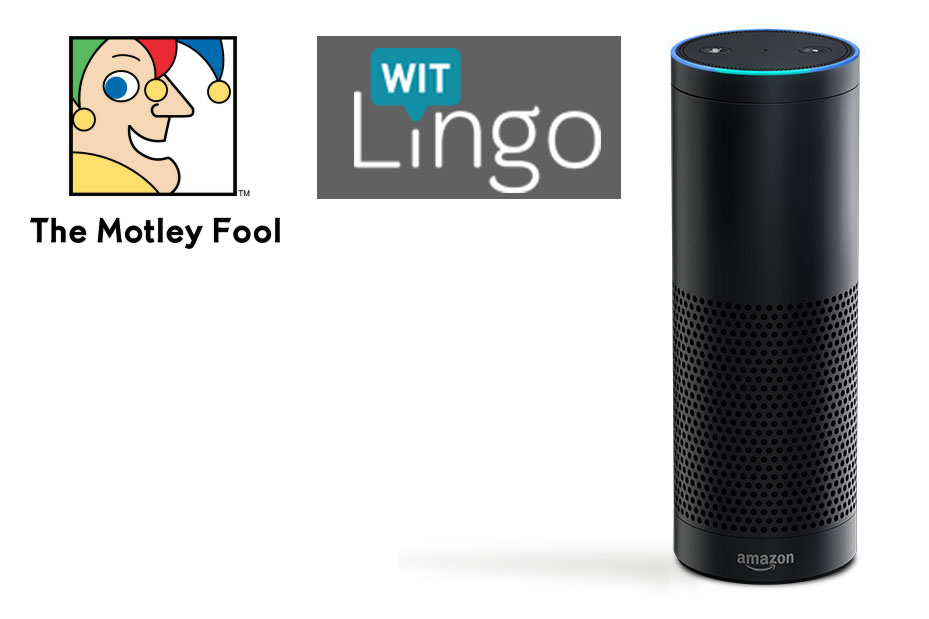Motley Fool Launches Alexa Skill with Help of Witlingo
 The Motley Fool has had a Flash Briefing available for Alexa since August. However, the Fool team led by Head of Product Tim Hanson decided there was an opportunity to offer more features to users by developing its own Alexa skill. Skills are more complex than Flash Briefings so Hanson engaged Ahmed Bouzid and his team at Witlingo to help design and build the skill. Voicebot connected with Hanson and Bouzid to discuss the project objectives and plans moving forward.
The Motley Fool has had a Flash Briefing available for Alexa since August. However, the Fool team led by Head of Product Tim Hanson decided there was an opportunity to offer more features to users by developing its own Alexa skill. Skills are more complex than Flash Briefings so Hanson engaged Ahmed Bouzid and his team at Witlingo to help design and build the skill. Voicebot connected with Hanson and Bouzid to discuss the project objectives and plans moving forward.
The Motley Fool is a great brand in the investment world with a top ranked website and mobile app. Why did you decide to also offer connectivity to your content through Amazon’s Alexa?
Tim Hanson (The Motley Fool): At The Motley Fool our mission is to help the world invest better. We originally had a print newsletter and then took our content online. However, we are constantly asking ourselves what are some new tools we can develop to help our users invest better. We don’t have a baseline to judge concrete goals with Alexa. However, we think it is a growth medium and we wanted to see how people would use it.
In August, you launched a Flash Briefing for Alexa users to access Fool news content. What made you decide to then go further and build a skill?
Hanson: Our demographic tends to skew a little older so we wanted to confirm there was an audience out there on the platform. The cost of putting out a flash briefing was very low and we already have a multimedia team putting out content each day so it was pretty easy. We started with a few hundred users, now the skill has thousands of users. It has been growing very quickly. That gave us confidence to invest the time and effort to build a skill. It convinced us that people who know The Fool are also Alexa users.
How is The Motley Fool Alexa skill different from the Flash Briefing?
Ahmed Bouzid (Witlingo): A Flash Briefing is nothing more than asking for content to be spoken to you. It is either recorded audio or text-to-speech [spoken by the Alexa voice] and up to 90 seconds in length, like on NPR when you hear a news summary. A skill is a conversation and an interactive experience. You ask for something and get back information for the user. It is a back and forth experience.
Hanson: You can ask how the market is doing. You can ask it for information on specific stocks. You can ask by ticker or by company name. You can also build a watch list of stocks over time and it will give you a quick rundown on everything you are interested in.
What was the biggest challenge you faced when building the original Flash Briefing for Alexa?
Hanson: The flash briefing launched over the summer, but it took a while to get out there. The way Amazon wanted to consume the content was different than the way our CDN wanted to distribute it. Eventually, we sorted that out.
You had already launched the Flash Briefing and had some familiarity with Alexa development, how come you decided to engage Witlingo and not just build the skill in-house?
Hanson: Witlingo approached us. They saw an opportunity because there wasn’t a lot of competition in the financial news space available on Alexa. It was nice to have a vendor approach us and work together.
Did you learn anything you didn’t expect when building the Alexa skill?
Hanson: As part of the project, we did some research on other [financial investing] skills on Alexa. It was interesting how deeply you have to think through something that is written down or accessible through an API and communicating that by voice. We found it was important to allow you to query the stock by the company name and not just by the ticker [symbol]. Finance is an industry where people use a lot of acronyms such as PE and those were interesting problems to solve.
Bouzid: Yes, there were some specific stumbling blocks. Because this skill has a speech component that is challenging, such as speaking the name of the stock, we had to work hard on the speech model. There are a lot of companies with different ways to say their names. We needed to make sure the names of the companies could be recognized when they were spoken in a way that users will ask.
Also, one of the metrics Witlingo offers is tracking how long each user interacts with the skill. It is a core part of our package to help companies build highly usable skills. What we are discovering through that data is the average session length for The Motley Fool skill is 50 seconds. So, we are seeing people interact several times during each session. We were astonished people are actually spending that long in the skill. It is a good indicator that the conversation interaction is working. This goes back to the core value proposition. For these applications to work, you need to understand usability as part of the design process.
How did you go about designing the skill?
Bouzid: The UX designer and myself came from Amazon. We had some ideas…but there was some learning to do. I was on the team that designed the local information skill for Alexa so I had a lot of best practices internalized. That guided me and the team on the UX.
As we worked to deploy this client and ensure they had the best skill possible, our UX designer did field research and talked to people. She first looked at the skills that had to do with stocks and then interviewed people who had used those skills and then others who had never used Alexa but were interested in investing information. [The field research] was informative in two ways. It helped us understand what frustrated people with existing skills. It also helped us understand how people expected to use the skill.
How long did it take?
Hanson: Two to two-and-a-half months to build.
Do you plan to take this to other platforms such as Google Home?
Hanson: We’d like to experiment with other voice platforms. Not sure about what will be next.
Do you have plans for any updates to the skill in terms of new functionality?
Bouzid: One thing we’ve noticed is skills being deployed by enterprises and hobbyists is that they are deployed and forgotten about. We are not seeing discipline of releasing products with a planned cadence of upgrades. I hope The Motley Fool skill is an indication that companies will start putting out skills and iterating on them to continually improve the value to the user.
Hanson: We want to see more about how the basic functionality is being used. How many people download the skill and use the skill. How many people are building watch lists. We have a database where we log all the opinions of our advisors. We could offer that in the future.
Do you have any other insights to offer Voicebot readers?
Bouzid: Some of the best practices suggested by Amazon are not great UX practices. Users do not want to hear a welcome to and goodbye. When people ask something by voice, they want to get right to that information and not have you welcome them. Similarly, they want to be done and not hear you say goodbye.
Companies building skills need to invest in the basics of how they will provide real value. Most of the skills have features that are dictated by the VP of Marketing. It’s a formula for disaster because they really have no idea what is needed. We saw this in spades with early mobile apps. Do not do armchair design so you can get a skill out quickly. It will hurt your brand. It will demoralize your team because you will have a skill that people don’t like.
Get a field researcher that goes and interviews people. Have them interview two types of people: those that have an Echo and those that do not. You will find that will offer you a solid MVP [minimum viable product] that you can get out. You will then be able to get your skill out with enough positive reaction that people will make it part of their life and will give you constructive feedback on how to improve it so it can grow into a healthy product.
You can learn more about The Motley Fool at Fool.com and Witlingo at Witlingo.com.









